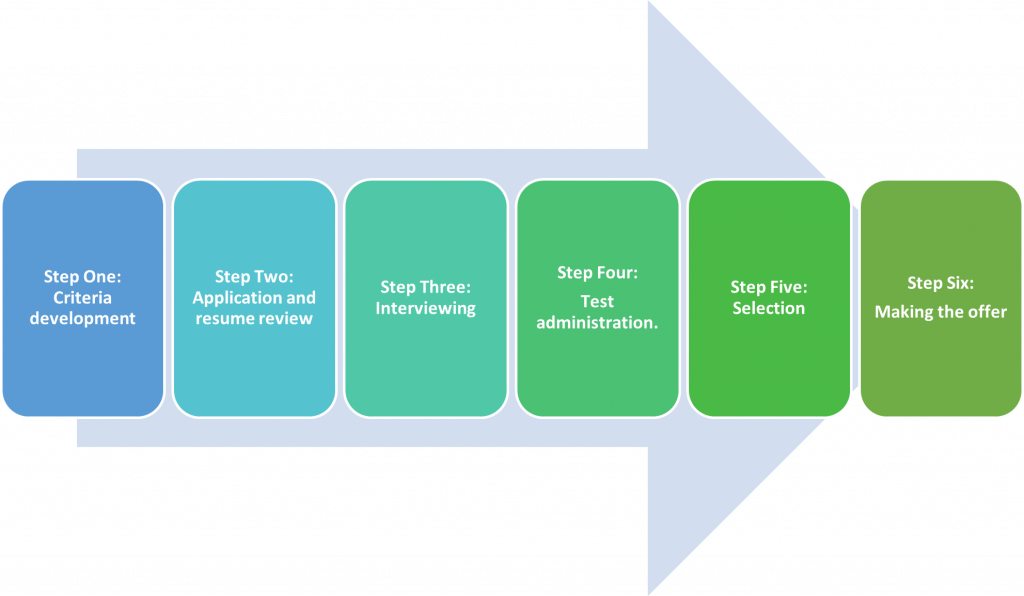10.4 The Selection Process
After recruitment has yielded a sufficient number of quality applications, the selection of candidates can begin. The selection process refers to the multiple steps involved in choosing people who have the right qualifications to fill a current or future job opening. While Operations managers and supervisors will usually have the ultimate decision as to who gets hired, you will work closely with the Human Resources Talent Acquisition team as they create a funnel, narrowing down the list of candidates and guiding managers in this process. Similar to the recruitment process, the selection process can be expensive. The time involved in the hiring process to review resumes, weigh the applications, and conduct interviews can be extensive and takes time (and money) away from other priority activities within the organization. In addition, there are financial implications of conducting testing of candidates and potential travel for in-person interviews. In fact, the US Department of Labor and Statistics estimates the combined direct and indirect cost of hiring a new employee can reach upwards of $40,000.[1] Due to the high costs, it is important to hire the right person from the beginning and ensure a fair selection process.
How to Select Employees
The selection process consists of six distinct aspects:

- Step One: Criteria development. The first aspect of selection is planning the interview process, which includes criteria development. Criteria development means determining which characteristics are sought for the position and how those characteristics will be assessed during the selection process. As previously mentioned, the criteria should be related directly to the job analysis and the job specifications. By developing the criteria before reviewing resumes, the HR manager can be sure they are being fair in selecting candidates to interview as they have not been influenced by information in the candidate’s application or resume. Some organizations may need to develop an application or a biographical information sheet. Most of these are completed online and should include information about the candidate, education, and previous job experience. Finally, identification of the selection criteria and weighting of the criteria should be determined at this stage, again to prevent influence from the information contained in the candidates’ resumes.
- Step Two: Application and resume review. Once the criteria have been developed, applications can be reviewed. Increasingly, HR managers use automated software to screen applications and resumes. These are based on keywords searches that narrow down the number of candidates’ resumes for review.
- Step Three: Interviewing. After the HR manager and hiring manager have determined which applications meet the minimum criteria, they must select those people to be interviewed. Most people do not have time to interview twenty or thirty candidates, so the list of candidates is reduced to a ‘short-list’ – typically to 3 to 5 candidates for a final round of screening.
- Step Four: Test administration. After the interview stage, a company may administer a test or series of tests before a hiring decision is made. These could include drug tests, physical fitness tests, personality tests, and/or cognitive tests. Increasingly, at this stage, companies also perform social media checks to confirm that the information in their resume is the same as posted online, or to see how applicants present themselves to the public.
- Step Five: Selection. At this point in the process, hiring manager(s) should have the information they need to select the best suitable candidate for the position. All of the information gathered throughout the process is reviewed and a decision is made. Once the ideal candidate is selected, some organizations also perform reference checks and credit report checks to confirm final suitability.
- Step Six: Making the offer. The last step in the selection process is to offer a position to the chosen candidate. The development of an offer via e-mail or letter is a formal part of the process and requires careful articulation of all elements and conditions of the offer. Compensation and benefits will be defined in an offer, as will any unique legal considerations.
The Selection Process at a Glance
| Step | Objectives |
|---|---|
| Criteria Development |
|
| Application and Resume Review |
|
| Interview |
|
| Test Administration |
|
| Selection |
|
| Making the Offer |
|
We will discuss each of these aspects in detail in the following section.
Criteria Development
Principles of Selection
Before reviewing resumes and applications, a company must have a clear idea of the education, skills, and abilities they want to hire for the position. While the job specifications derived from the job analysis will help to understand which qualifications are required, it is also important to decide how these will be assessed. Organizations have access to a wide variety of tools to assess candidates’ KSAOs, and when structuring the selection process, there are a few principles to keep in mind.
Sequencing Based on Cost
Some KSAO’s are objective and very easy to measure. For example, whether someone has a Bachelor’s Degree in Biology or a truck driver’s license is easy to determine by looking at the resumes. Whether someone is a team player or can handle stress is not as straightforward to assess. This KSAO could be measured with an interview or a simulation, two relatively costly processes. In order to efficiently narrow down a list of applicants, hiring managers will begin by screening for those more objective, easy-to-assess KSAOs and leave the expensive tests and checks for later in the process.
Organizational Fit
Fit includes not only the right technical expertise, education, and experience or the KSAO’s derived from the job analysis, but also fit in the company culture and team culture. This means that companies can select based on criteria that go above and beyond the specific elements of the job. At Amazon, a core value in their company culture is a focus on developing leaders to grow with the organization. If a potential candidate is not interested in long-term career growth, he or she might not be deemed an appropriate strategic fit with the organization. In today’s organizations, most people are required to work within teams. As a result, fit within a team is as important as the fit with company culture. Microsoft, for example, does an immense amount of teamwork. The company is structured so that there are marketers, accountants, developers, and many others working on one product at the same time. As a result, Microsoft looks for not only company culture fit, but also fit with other team members.
Application and Resume Review
The selection of employees is a complex process, involving many important steps. As a result of technological advances and research in psychology, this process has also evolved dramatically over the years. Interestingly, there are two elements of the selection process that have remained very stable over the years: the use of the resume (or CV) and the use of the interview.
Applications
In years past it was generally accepted practice to require a job candidate to complete a job application – with or without the added requirement of suppling a resume (resume is French for ‘summary’) or cv (curriculum vitae (CV) is Latin for ‘course of life’). In more recent history, the resume has displaced the need for a formal job application with many organizations.
Resumes
Resumes are the key piece of information used to select candidates. This document is a summary of a candidate’s education, work experience, and skill set. A quick web search will yield hundreds of articles on how to write the perfect resume. Given the prevalence of the resume in the selection process, it is very important to have one on file, ready to go if an interesting opportunity arises. The Career Services department at Fanshawe College is a unit that provides career services to assist students and alumni in their employment search.
Operations Manager Toolkit
“The Selection Process” in Human Resources Management – 2nd Ontario Edition by Elizabeth Cameron is licensed under a Creative Commons Attribution-NonCommercial-ShareAlike 4.0 International License, except where otherwise noted.
- IHD Corporation. (n.d.). Pre-Employment Testing. https://ihdcorp.com/assets/ihdcorp_pre-employmenttesting.pdf ↵


